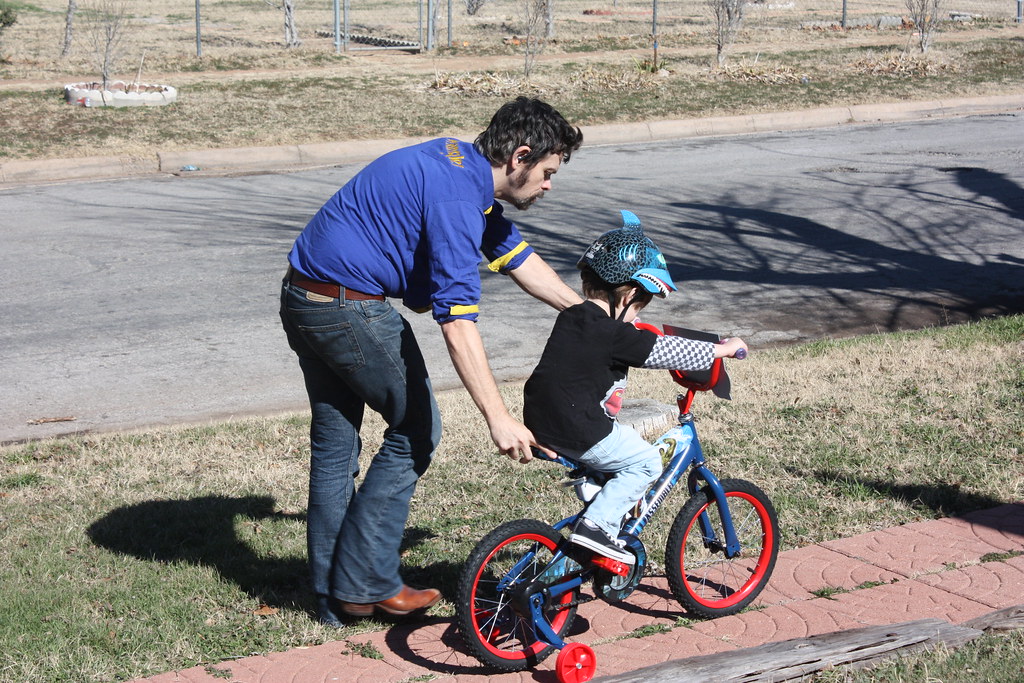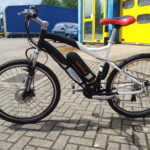Are you wondering, “How do I teach my son to ride a bike?” It’s a common question that many parents face as they witness their child growing up. In this blog, we will address the practicalities and considerations surrounding this task. We will focus on effective teaching methods and strategies.
From selecting the appropriate bike to offering support and encouragement, we will outline actionable steps to ensure a successful and enjoyable learning experience for both parent and child.
As parents, teaching your son to ride a bike can be as rewarding for you as it is for them. It’s a bonding experience filled with laughter, encouragement, and sometimes a few scraped knees.
The question, “How do I teach my son to ride a bike?” is frequently asked, and we aim to provide clear and concise guidance to facilitate this process. Let’s get started and give you the tools and know-how to teach your son to ride a bike confidently.
When Is a Child Ready to Ride a Bike?
Determining the right time for a child to start riding a bike is a blend of developmental cues and enthusiasm. Parents should observe their child’s coordination, balance, and fine motor skills, which are crucial for managing a bicycle.

Typically, children show readiness between ages three to six when they start to master tasks that require a combination of these skills. It’s also essential to gauge their interest in biking; a child eager to ride is more likely to learn quickly.
Look for signs of independence, such as the desire to explore and play outside. Physical growth is another factor; ensure they can place their feet flat on the ground when seated on a bike.
Ultimately, a child’s confidence and ability to follow instructions will signal their readiness to embark on the journey of riding a bike.
How Do I Teach My Son to Ride a Bike?
Follow this step-by-step guide to learn how to teach a child to ride a bike:
1. Choosing the Right Bike
Selecting the ideal bicycle for a child is pivotal in ensuring a safe and enjoyable learning experience. The correct bike size aligns with the child’s age and height, preventing strain and promoting better handling.
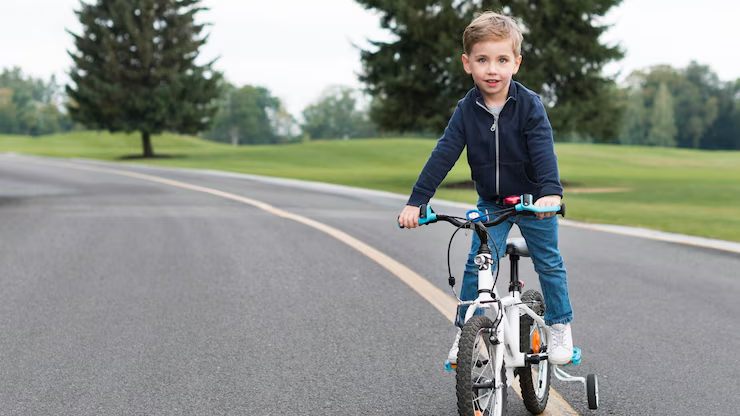
For beginners, a bike with training wheels provides stability as they hone their pedaling and steering skills. An adjustable seat is crucial; it should allow the child’s feet to touch the ground comfortably, ensuring control and confidence.
Similarly, adjustable handlebars aid in finding the perfect reach, making rides more comfortable. These features not only accommodate growth spurts but also help in transitioning to two wheels.
When adjusting the bike, prioritize a slight bend in the knee when the pedal is at its lowest point, and ensure the handlebars are at a level where the child can maintain an upright posture for full control.
2. Safety Gear
Equipping a child with the right safety gear is crucial for any bike-riding adventure. A helmet is the most critical piece, acting as a shield for the brain in case of falls.

It should sit snugly on the head, with the front rim barely above the eyebrows and the straps forming a ‘V’ around the ears, buckled just below the chin.
Knee and elbow pads are also essential, offering protection to joints during tumbles. They should be tight enough to stay in place but not so restrictive that they hinder movement. Ensuring these items fit correctly is key to their effectiveness.
Parents should check that helmets and pads stay in place as the child moves and make adjustments as needed.
3. Where to Teach Bike Riding?
Choosing the right location for teaching bike riding is as crucial as the bike itself. A spacious, flat area free from traffic, like a park or an empty parking lot, provides the perfect setting. Such environments allow children to practice without the fear of cars, helping them focus on balance and pedaling.

The openness of these areas gives ample room for trial and error, essential for mastering bike riding. Parks often have designated paths that are ideal for beginners, offering a safe distance from pedestrians and other distractions.
An empty parking lot during off-hours is another excellent option, providing a large, obstacle-free space. The key is to find a location that is not only safe but also comfortable for both the child and the parent, ensuring a stress-free learning experience.
4. How to Turn a Bike into a Temporary Balance Bike?
Transforming a standard kid’s bicycle into a balance bike is a straightforward process that enhances a child’s coordination and balance. Begin by positioning the bike securely and gathering the necessary tools: a wrench and screwdriver.

Carefully unscrew the pedals, ensuring to keep the crank arms intact. This simple adjustment allows children to focus on balancing without the complexity of pedaling. Encourage the young rider to stride and glide, using their feet to propel forward.
This method promotes the development of motor skills and confidence in handling a two-wheeler. Once the child has mastered balance, reattach the pedals, which is a quick and easy task.
This temporary modification serves as an excellent transition, fostering a seamless progression to a traditional pedal bike.
5. Teaching Techniques
Effective teaching techniques for cycling begin with balance and coordination exercises. Initially, remove the pedals from the bicycle, allowing the child to focus on scooting with both feet firmly on the ground.
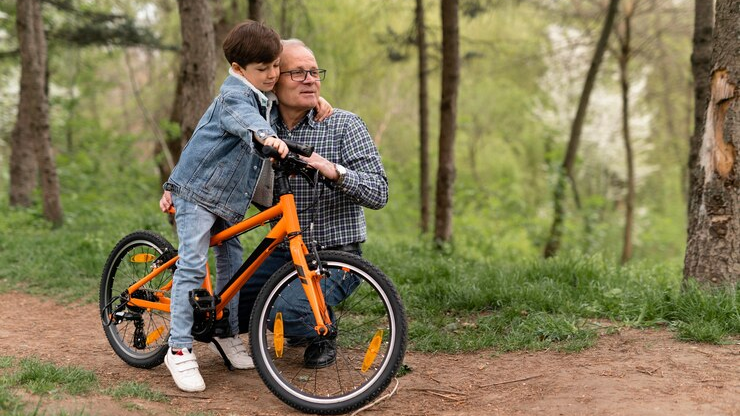
This step is crucial for developing a sense of balance. Once the child is comfortable, reinstall the pedals and introduce the concept of pedaling. Demonstrate the motion and gently encourage the child to mimic the action.
Throughout this learning process, it’s essential to use positive reinforcement. Celebrate each milestone, no matter how small, and provide constant encouragement. This approach not only builds cycling skills but also boosts the child’s self-esteem and eagerness to learn.
6. Practicing Riding Skills
Practicing riding skills is essential for mastering bicycle control. Start by learning to push off and glide, focusing on steady steering. Grip the handlebars firmly but not too tightly, as this will help in maneuvering.

Pedaling comes next; maintain a consistent rhythm to build momentum. Balancing is key—keep your body centered over the bike. For stopping, apply the brakes gently but firmly to avoid a sudden halt.
Practice these steps in a safe, open area until they become second nature. This methodical approach to learning each aspect of riding ensures safety and builds a solid foundation for enjoying cycling adventures.
7. Overcoming Challenges
Overcoming challenges in learning to ride a bicycle, especially for young riders, often involves conquering the fear of falling, overcoming frustration, and boosting self-confidence. It’s important to acknowledge these feelings and address them head-on.

Building resilience can be as simple as allowing for short breaks during practice sessions, which helps to refresh focus and determination. Setting small, achievable goals can provide a clear path forward, making the task less daunting.
Each small victory should be celebrated, reinforcing the child’s belief in their abilities. This positive reinforcement helps to cultivate a mindset that views challenges as opportunities for growth.
By maintaining a supportive environment and encouraging a step-by-step approach, learners can gradually build the skills and confidence needed to master bicycle riding, turning apprehensions into accomplishments.
8. Graduating from Training Wheels
Transitioning from training wheels to riding solo is a significant step in a child’s cycling journey. It’s best to make this shift when the child feels comfortable and shows interest in trying without extra support.
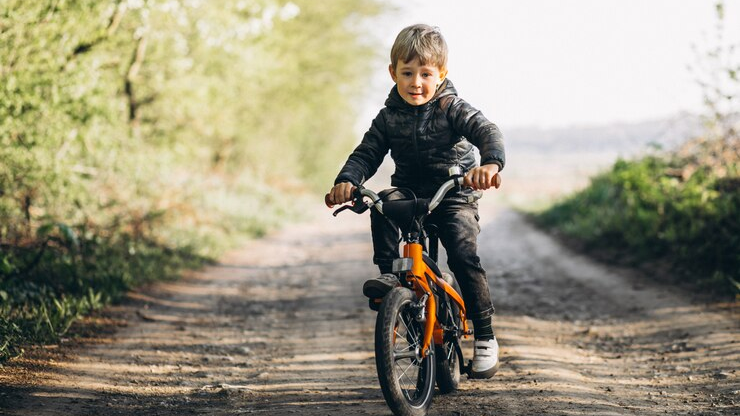
Begin by ensuring the bike is the correct size, as this affects balance and confidence. Lower the seat so the child can touch the ground with their feet, providing stability. Start on a soft surface like grass, which can ease the fear of falling.
Gradually move to a flat, smooth surface as they improve. Encourage them to look ahead, not at the wheels, to improve balance. Be present, offering physical support and reassurance as needed.
As they gain confidence, let them ride independently for short distances. Celebrate their progress, and remind them that it’s okay to make mistakes. With patience and practice, they’ll soon be pedaling with pride.
Celebrating Success
Now you know how to teach a kid to ride a bike. The next phase of witnessing a child conquer the challenge of riding a bike independently is a momentous occasion that deserves celebration. It’s a significant milestone that marks not just a newfound mobility but also the growth of confidence and independence.
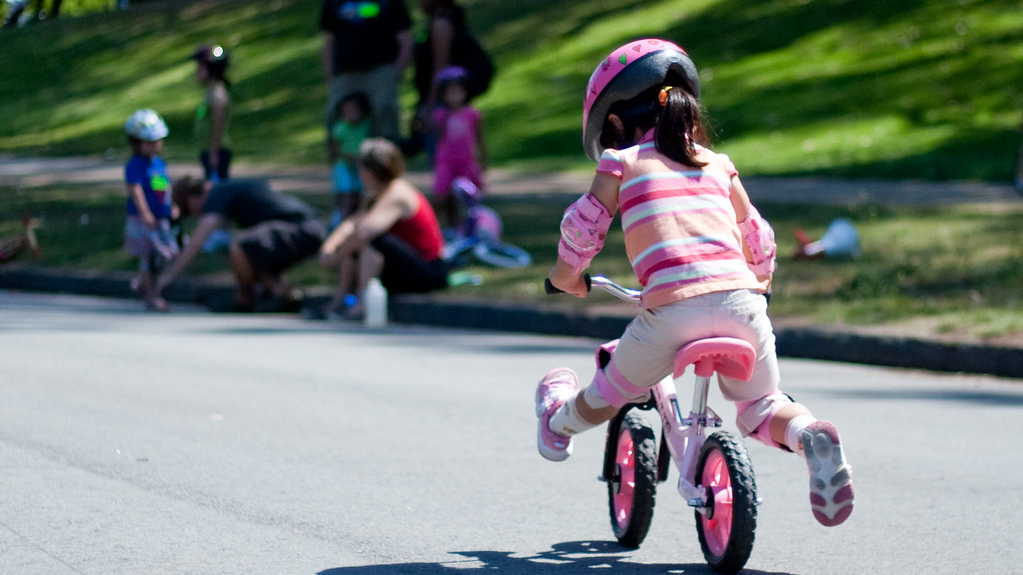
To commemorate this achievement, consider organizing a small family gathering where the child can demonstrate their new skill. Applaud their effort with cheers and perhaps a certificate of accomplishment to reinforce their success.
Capture these precious moments with photos or a short video, creating lasting memories of their beaming pride. This celebration isn’t just about the physical act of balancing on two wheels; it’s about recognizing the perseverance and bravery it took to get there.
It’s a chance to show your child that their hard work pays off, setting a positive precedent for future challenges. This joyous occasion is a perfect opportunity to bond and instill values that will last a lifetime.
How to Help a Child Who Can’t Pedal Forward?
Assisting a child who struggles with pedaling forward on a bicycle involves patience and encouragement. Begin by ensuring the bike is the correct size; their feet should touch the ground comfortably.

Next, guide them through the motion of pedaling in a stationary position, perhaps using a wall for support. Once they understand the motion, encourage them to practice on a slight decline, which naturally propels the bike forward, reducing the initial effort required to pedal.
Keep the sessions short to prevent frustration, and celebrate small victories to boost their morale. If progress stalls, consider pedal-less balance bikes, which can improve their confidence and understanding of motion.
Conclusion
Hope you’ve found out how do I teach my son to ride a bike? It is a journey filled with little triumphs and learning experiences. Start with the basics of balance and steering, gradually moving to pedaling and braking. Equip them with the right safety gear and choose a safe, flat area for practice.
Be patient and offer constant encouragement; every child learns at their own pace. Celebrate each achievement, whether it’s gliding for a few seconds or taking those first solo pedals. Your support is crucial in nurturing their confidence and independence.
Remember, this process is not just about riding a bike—it’s about building lifelong skills and memories together.
FAQs
It can take a few weeks to months, depending on the child’s coordination and practice frequency.
Boys often learn to ride a bike between 3 to 7 years old.
It’s never too late to learn to ride a bike; adults can learn too.
Guide and motivate, but never force a child to ride a bike.

